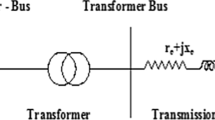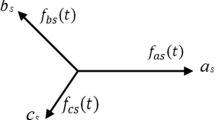Abstract
The power angle stability analysis is most important for a grid-connected alternator. This stability may be classified under transient or steady state. The steady state stability may again be classified as static and dynamic. Steady state stability is concerned for slow changes, often in the presence of automatic control systems. Transient stability is the stability of a machine or a group of machines under a sudden impact, e.g., a sudden change in load or a sudden change in generation or in network parameters. The recent practice is to deal with both these problems in terms of state variables for their various advantages. This paper presents the state variable description of an alternator under normal operating conditions and its deviation from normalcy due to a sudden change, e.g., a sudden short-circuit and subsequent operation of the breakers. Then, the power angle swing (\(\delta ,\omega\)) has been computed using state variables. Infinite bus idealization has been made for the alternator as the capacity of the set (s) is small compared to that of the regional power grid. The classical model based on Park–Gorev transformation has been used to represent the machines. The state space models have been developed from it. The next task is to include the effect of exciter.



Similar content being viewed by others
Abbreviations
- \(\omega\) :
-
Angular speed of the generator, rad/s
- \(\delta\) :
-
Power angle, rad
- \(i_{d} ,i_{q}\) :
-
d- and q- axes components of armature current
- \(v_{d} ,v_{q}\) :
-
d- and q- axes components of armature voltage
- \(X_{d} ,X_{q}\) :
-
d- and q- axes synchronous reactance
- \(X_{d}^{'}\) :
-
d-axis transient reactance
- \(E,E_{FD}\) :
-
Induced e.m.f, exciter output
- \(V_{t} ,V_{b}\) :
-
Voltage at generator terminal, infinite bus
- \(D\) :
-
Damping constant
- \(H\) :
-
Inertia Constant
- \(K_{A} ,T_{A} ,K_{F} ,T_{F}\) :
-
Constants related to exciter model IEEE, type 1s
- \(E^{'} ,E_{q}^{'}\) :
-
Voltage behind transient reactance/ its q-axis component
- \(T_{do}^{'} ,T_{d}^{'}\) :
-
d-axis O.C. / S.C. transient time constant
References
K. Ogata, State Space Analysis of Control Systems (Prentice-Hall, New Jersey, 1967)
R.H. Park, Two reaction theory of synchronous machines Part. 1, Trans. Am. Inst. Electr. Eng. 48 (1929); Part. 2. 52 (1933)
G. Shackshaft, General purpose turbo-alternator model. Proc. IEE 110(4), 703–713 (1963)
B. Adkins, G. Harley, Generalized Theory of AC Machines (Chapman and Hall, London, 1957)
W. Stagg, A.H. EI-Abied, Computer Methods in Power System Analysis (McGraw-Hill Book Company, New York, 1968)
P.M. Anderson, A.A. Fouad, Power System Control and Stability (IOWA State University Press, Galgotia Publications, Lowa city, 1977)
P. Kundur, P.L. Dandeno, Implementation of advanced generator models into power system stability programs. IEEE Trans. Power Appar. syst. 7, 2047–2054 (1983)
J.Y. Fan, T.H. Crtrneyer, R. Mukundan, Power system stability. IEEE Trans. Power Syst. 5(1), 227–233 (1990)
M. Pavella, P.G. Moorthy, Transient Stability of Power Systems: Theory and Practice (Scitech, Goiás, 1994)
P. Kundur, Power System Stability and Control (McGraw Hill, New York, 1994)
IEEE recommended practice for excitation system models for power system stability studies, IEEE Standard 421-5-1992
K.R. Padiyar (IIT, Bangalore), Power system dynamics, 2008, ISBN: 1 904798 012
V. Venikov, Transient Processes in Electric Power System (MIR Publishers, Moscow, 1980)
F. Selwa, L. Djamel, Transient stability analysis of synchronous generator in electrical network, International Journal of Scientific and Engineering Research, 5(8) (2014), ISSN 2229-5518 IJSER © 2014
Author information
Authors and Affiliations
Corresponding author
Additional information
Publisher's Note
Springer Nature remains neutral with regard to jurisdictional claims in published maps and institutional affiliations.
All quantities are in p.u. unless otherwise mentioned. Time-constants are in sec.
Rights and permissions
About this article
Cite this article
Ghosh, A., Das, A. & Sanyal, A. Transient Stability Assessment of an Alternator Connected to Infinite Bus Through a Series Impedance Using State Space Model. J. Inst. Eng. India Ser. B 100, 509–513 (2019). https://doi.org/10.1007/s40031-019-00397-w
Received:
Accepted:
Published:
Issue Date:
DOI: https://doi.org/10.1007/s40031-019-00397-w




